
Hamnah
MemberForum Replies Created
-
::
To find the original cost of the shirt
Let the original cost be x
The markup percentage is 25%, which means the store is selling the shirt for 100% + 25% = 125% of the original cost.
So now the equation is
x + 25% of x = $40We can write 25% as 0.25
So, x + 0.25x = $40
1.25x = $40
x = $40 / 1.25
x = $32
Therefore, the original cost of the shirt was $32.
So, the correct answer is option c)$32.
-
::
Fish Anatomy: Designed for Aquatic Locomotion<div>
<div>Fish exhibit remarkable adaptations that enable them to thrive and move efficiently in water. Through evolutionary processes, their bodies have undergone significant modifications, resulting in unique features that facilitate swimming and survival.</div><div>
</div><div>1. Streamlined Body Shape: </div><div> – Aquadynamic Design: The elongated and tapered body shape reduces drag and resistance, allowing fish to move swiftly through water.</div><div> – Minimized Friction: This streamlined form minimizes energy expenditure and facilitates efficient locomotion.</div><div>
</div><div>2. Fins: Propelling and Maneuvering</div><div> – Caudal Fin (Tail Fin): The primary source of propulsion, the caudal fin, or tail fin, propels the fish forward by creating thrust through side-to-side movements.</div><div> – Dorsal and Anal Fins: These fins contribute to stability, preventing rolling or flipping while swimming.</div><div> – Pectoral and Pelvic Fins: Responsible for steering, balancing, and making precise movements, these fins aid in maneuverability.</div><div>
</div><div>3. Scales: Protection and Hydrodynamics</div><div> – Protective Armor: Overlapping scales cover the fish’s body, providing physical protection against injuries.</div><div> – Streamlined Surface: The scales create a smooth and hydrodynamic surface, reducing drag and enhancing the fish’s ability to glide through water.</div><div>
</div><div>4. Swim Bladder: Buoyancy Control</div><div> – Buoyancy Regulation: Fish possess a gas-filled swim bladder, which can be adjusted to control their buoyancy in water.</div><div> – Depth Control: By altering the volume of gas in the swim bladder, fish can ascend or descend in the water column to maintain their desired depth.</div><div>
</div><div>5. Muscular System: Efficient Propulsion</div><div> – Myomeres: Fish have a segmented arrangement of powerful muscles called myomeres.</div><div> – Undulating Motion: Contraction and relaxation of myomeres create undulating waves along the body, generating forward propulsion and allowing for agile movement.</div><div>
</div><div>6. Gills: Efficient Respiration</div><div> – Respiratory Adaptation: Fish have specialized respiratory organs called gills.</div><div> – Extracting Oxygen: Gills extract dissolved oxygen from water, facilitating efficient respiration while submerged.</div><div>
</div>So im conclusion, the design of a fish’s body exhibits specialized adaptations to ensure efficient swimming and survival in water. From the streamlined body shape and various fins for propulsion and maneuverability to the protective scales, swim bladder for buoyancy control, and efficient respiratory system with gills, each aspect of fish anatomy contributes to their successful aquatic locomotion. These adaptations have allowed fish to thrive in diverse aquatic habitats and navigate through their environments with remarkable ease and agility.
</div>
-
::
Chat GPT is an advanced language model developed by OpenAI. It is powered by deep learning techniques and trained on vast amounts of text data to generate human-like responses and engage in natural language conversations. Chat GPT, specifically based on the GPT-3.5 architecture, is designed to assist users in various tasks, provide information, answer questions, and engage in meaningful conversations on a wide range of topics.
A school student can use Chat GPT as a valuable tool to support their learning and academic pursuits. Here are some ways a student can benefit from using Chat GPT:
1. Information Retrieval: Chat GPT can provide quick and accurate information on various subjects, helping students with their research projects, homework assignments, or general knowledge queries.
2. Concept Clarification: Students can ask questions to clarify concepts they find challenging in subjects like math, science, or literature. Chat GPT can provide explanations and examples to enhance understanding.
3. Writing Assistance: Chat GPT can assist students in generating ideas, offering suggestions for essay topics, providing writing tips, or proofreading their work for grammar and clarity.
4. Study Aid: Students can use Chat GPT to create flashcards, practice quizzes, or even simulate study group discussions. It can also help in retrieving definitions, explanations, or summaries of specific topics.
5. Language Practice: Chat GPT can act as a conversational partner to practice language skills, improve vocabulary, or seek language-related guidance.
While Chat GPT can be a valuable resource, it’s important to acknowledge its limitations. It’s an AI language model that provides responses based on patterns and examples in the training data. Although it strives to be accurate and helpful, there may be instances where the responses are not entirely accurate or appropriate.
Chat GPT should be used as a supplemental tool alongside human guidance and critical thinking. Students should actively engage with the information provided by Chat GPT, verify it from reliable sources, and seek clarification or guidance from teachers or subject matter experts when needed.
So in short Chat GPT has the potential to be a helpful resource for school students by providing information, clarifying concepts, assisting in writing, and acting as a study aid. However, students should approach it with critical thinking, use it as a supplement to their learning process, and consult human experts when necessary to maximize its benefits and ensure accurate understanding.
-
::
An ecosystem refers to a complex network of living organisms, their physical environment, and the interactions between them. It encompasses both the biotic (living) and abiotic (non-living) components of a specific geographical area or habitat. Ecosystems are characterized by the flow of energy and the cycling of matter, creating a dynamic balance and supporting the diverse forms of life within them.
Ecosystems can vary greatly in scale and can be found in diverse environments such as forests, oceans, grasslands, deserts, and even within our own urban landscapes. They can be as small as a pond or as large as an entire biome. Regardless of their size, all ecosystems share fundamental elements and processes.
Biotic components of an ecosystem include plants, animals, fungi, and microorganisms. These organisms interact with one another in various ways, forming intricate food chains and webs. For example, in a forest ecosystem, trees provide shelter and nutrients for birds, while birds, in turn, disperse seeds and control insect populations. Insects may pollinate flowers and decompose organic matter, contributing to nutrient cycling.
Abiotic components encompass the non-living factors that shape the ecosystem. These include sunlight, temperature, water availability, soil composition, air quality, and geological features. These abiotic factors influence the distribution and abundance of organisms within the ecosystem. For instance, the availability of water and temperature range determine the types of plants and animals that can survive in a desert ecosystem.
An example of an ecosystem is the coral reef. Coral reefs are vibrant marine ecosystems teeming with life. The corals, which are living organisms, form the framework of the reef. They provide shelter and food for a wide variety of fish, crustaceans, and other marine organisms. Algae and plants within the reef perform photosynthesis, converting sunlight into energy and oxygen. The coral reef ecosystem also includes abiotic factors such as water temperature, sunlight penetration, and nutrient availability, which influence the health and diversity of the ecosystem.
Ecosystems are highly interconnected and can be sensitive to disturbances. Human activities, such as pollution, deforestation, and climate change, can disrupt these delicate balances, affecting the health and functioning of ecosystems. Understanding and preserving ecosystems are crucial for maintaining biodiversity, providing ecosystem services, and ensuring the sustainability of our planet.
-
::
“Distracted Driving: A Major Hazard on the Road”
Driving is a daily activity for many individuals, but it comes with inherent risks. One of the most significant hazards on the road today is distracted driving. This essay explores the dangers associated with distracted driving, its causes, and the importance of raising awareness to address this pressing issue.
Distracted driving involves any activity that diverts a driver’s attention from the task of operating a vehicle safely. The most common forms of distractions include using mobile devices, such as texting or talking on the phone, eating or drinking, talking to passengers, grooming, adjusting in-car technologies, and daydreaming.
The consequences of distracted driving can be devastating. It reduces a driver’s reaction time, impairs judgment, and increases the likelihood of accidents. Studies have shown that distracted driving is a leading cause of road accidents, injuries, and fatalities.
Raising awareness about the dangers of distracted driving is crucial for prevention. Education and public campaigns play a vital role in informing drivers about the risks and consequences. By emphasizing the importance of focused driving, drivers can make informed decisions and prioritize safety.
Legislation and enforcement also play a critical role in combating distracted driving. Stricter laws and penalties can act as deterrents and promote responsible behavior behind the wheel. Many jurisdictions have implemented laws prohibiting texting and driving, as well as the use of handheld devices while driving.
Technological advancements can contribute to the prevention of distracted driving. Car manufacturers are developing hands-free technologies and voice-activated systems to minimize manual and visual distractions. However, it is important for drivers to use these technologies responsibly and avoid unnecessary interactions while driving.
Community engagement is essential in addressing distracted driving. By involving schools, driving institutions, and local organizations, we can create a culture of responsible driving. Encouraging open discussions, organizing awareness events, and engaging peers and families can promote safer driving habits and discourage distracted behaviors.
So in conclusion, distracted driving poses a significant hazard on the road. It is essential for drivers to recognize the risks, understand the consequences, and commit to responsible driving habits. By raising awareness, implementing stricter laws, leveraging technology, and fostering community engagement, we can work towards reducing distracted driving incidents and creating safer roads for everyone. Remember, the focus should always be on the road and the safety of all road users.
-
::
Women Empowerment: Unleashing the Potential of Women
Women empowerment is the process of enabling women to have control over their lives, make independent choices, and actively participate in all aspects of society. It seeks to dismantle gender inequalities and create a more equitable world where women can thrive and contribute their talents.
Women empowerment is not just a concept; it is a movement that has sparked transformative changes worldwide. One famous quote by Mahatma Gandhi encapsulates the essence of women empowerment: “If you want to know the real character of a society, look at how it treats its women.”
To understand the significance of women empowerment, we can turn to the inspiring story of Malala Yousafzai. Born in Pakistan, Malala fearlessly stood up against the Taliban’s oppressive regime that denied girls’ education. Despite facing grave threats, she championed for girls’ right to education through her blogs and public speaking.
Malala’s unwavering determination and courage garnered global attention, earning her the Nobel Peace Prize in 2014. Her journey serves as a powerful example of how one individual can ignite change and empower others. Malala continues to advocate for education as a fundamental right, inspiring millions of girls worldwide to pursue their dreams.
Women empowerment is not limited to the fight for education; it extends to economic independence and political participation. When women are economically empowered, they gain financial autonomy and decision-making power. This can be seen in the success stories of women entrepreneurs and leaders who have shattered glass ceilings and achieved remarkable milestones.
Political representation is equally crucial for women empowerment. Countries that prioritize women’s participation in decision-making processes benefit from more inclusive policies. Women’s voices and perspectives bring fresh insights and tackle issues that affect women’s rights, health, and overall well-being.
Women empowerment is a vital catalyst for social progress. Through education, economic empowerment, and political representation, women can break barriers, challenge stereotypes, and transform societies. Malala Yousafzai’s inspirational journey reminds us that every individual has the power to make a difference. By empowering women, we create a ripple effect that uplifts families, communities, and nations, leading to a more equitable and prosperous world for all.
-
::
Global warming and climate change are complex issues that have profound causes and far-reaching consequences.
Causes of Global Warming and Climate Change:
– Greenhouse Gas Emissions: Burning fossil fuels (coal, oil, and natural gas) for energy production and transportation releases significant amounts of carbon dioxide (CO2), the primary greenhouse gas responsible for global warming. Other activities, such as deforestation and land-use changes, also contribute to CO2 emissions.
– Methane Emissions: Agricultural practices, particularly livestock farming and rice cultivation, release methane (CH4), a potent greenhouse gas. Methane is also emitted from landfills, coal mining, and oil and gas production.
– Nitrous Oxide Emissions: Agricultural and industrial activities, including the use of synthetic fertilizers and the combustion of fossil fuels, release nitrous oxide (N2O), another potent greenhouse gas.
– Deforestation: Clearing forests for agriculture, logging, and urbanization reduces the Earth’s capacity to absorb CO2 through photosynthesis, contributing to higher atmospheric CO2 levels.
– Industrial Processes: Industrial activities, such as cement production and chemical manufacturing, emit greenhouse gases and contribute to global warming.
Consequences of Global Warming and Climate Change:
– Rising Temperatures: Global warming leads to higher average temperatures worldwide, resulting in heatwaves and increased frequency of extremely hot days.
– Melting Ice and Rising Sea Levels: Warming temperatures cause glaciers and polar ice caps to melt, leading to rising sea levels. This poses risks to coastal regions, exacerbating coastal erosion and increasing the likelihood of flooding during storms.
– Extreme Weather Events: Climate change intensifies extreme weather events, including hurricanes, droughts, heatwaves, and heavy rainfall. These events have far-reaching consequences for ecosystems, agriculture, infrastructure, and human livelihoods.
– Ecosystem Disruptions: Changes in temperature and precipitation patterns disrupt ecosystems, affecting biodiversity, migration patterns of animals, and the timing of plant flowering and reproduction.
– Water Scarcity: Climate change alters rainfall patterns, leading to increased droughts in some regions and more intense rainfall in others. This can result in water scarcity, impacting agriculture, access to clean drinking water, and overall water availability.
– Health Impacts: Climate change contributes to the spread of diseases, such as vector-borne illnesses like malaria and dengue fever, as warmer temperatures expand the range of disease-carrying organisms.
– Economic Consequences: The impacts of global warming and climate change have significant economic implications, including damage to infrastructure, increased costs for disaster response and recovery, reduced agricultural productivity, and potential displacement of populations.
Addressing the causes and consequences of global warming and climate change requires concerted efforts to reduce greenhouse gas emissions, transition to renewable energy sources, protect ecosystems, implement sustainable land-use practices, and promote resilience and adaptation measures in vulnerable communities.
 Tall & Short Worksheets for Preschool - Free Printables
Tall & Short Worksheets for Preschool - Free Printables 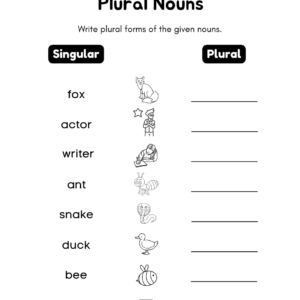 Singular to Plural Writing Worksheet
Singular to Plural Writing Worksheet 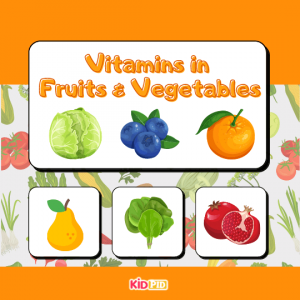 Vitamins in Fruits & Vegetables Book
Vitamins in Fruits & Vegetables Book 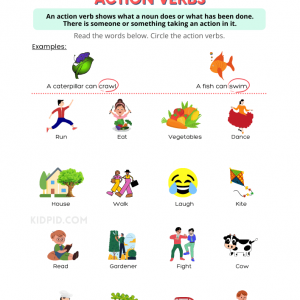 Identify Action Verbs Printable Worksheets for Grade 1
Identify Action Verbs Printable Worksheets for Grade 1 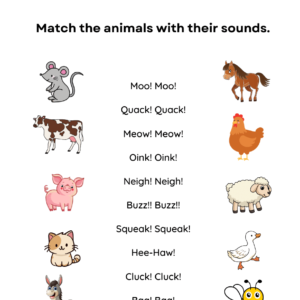 Animal Sound Match Worksheet
Animal Sound Match Worksheet 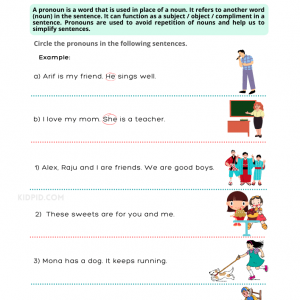 Identification of Pronouns Worksheets for Grade 2
Identification of Pronouns Worksheets for Grade 2 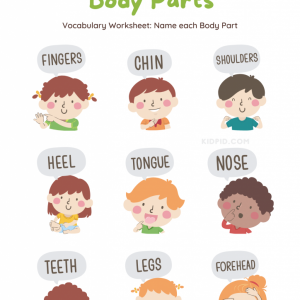 Vocabulary Naming Body Parts Worksheet
Vocabulary Naming Body Parts Worksheet 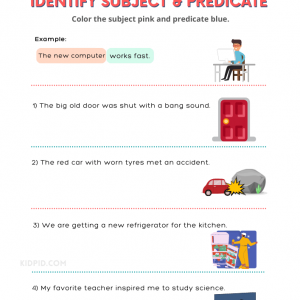 Identify Subject and Predicate Free Printable Worksheets for Grade 2
Identify Subject and Predicate Free Printable Worksheets for Grade 2 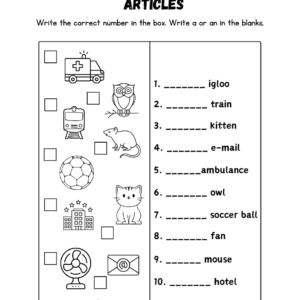 Articles(a,an) - English Grammar Worksheets
Articles(a,an) - English Grammar Worksheets 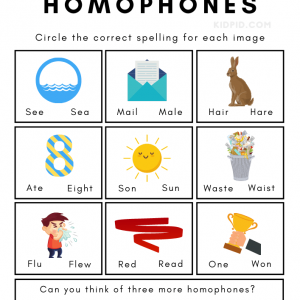 Homophones Worksheets for Grade 1
Homophones Worksheets for Grade 1  Math Expanded Form Worksheets for Grade 2
Math Expanded Form Worksheets for Grade 2  Tracing and Writing Number & Words 1-9 Worksheets
Tracing and Writing Number & Words 1-9 Worksheets